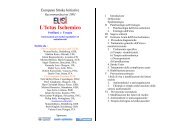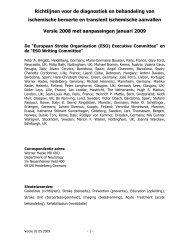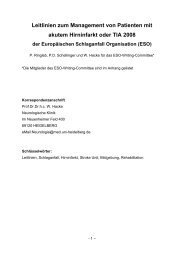Guidelines for Management of Ischaemic Stroke 2008 - ESO
Guidelines for Management of Ischaemic Stroke 2008 - ESO
Guidelines for Management of Ischaemic Stroke 2008 - ESO
Create successful ePaper yourself
Turn your PDF publications into a flip-book with our unique Google optimized e-Paper software.
<strong>ESO</strong>-<strong>Guidelines</strong> <strong>for</strong> <strong>Management</strong> <strong>of</strong> <strong>Ischaemic</strong> <strong>Stroke</strong> <strong>2008</strong><br />
start oral anticoagulation. After TIA or minor stroke one could start immediately, but<br />
after major stroke with significant infarction upon neuroimaging (e.g. above a third <strong>of</strong><br />
the MCA territory) one should wait <strong>for</strong> some (e.g. 4) weeks. However, this decision<br />
has to be individualized.<br />
In patients with AF and stable coronary disease, aspirin should not be added to oral<br />
anticoagulation [331]. Anticoagulation may be beneficial in patients with aortic<br />
atheroma [332], fusi<strong>for</strong>m aneurysms <strong>of</strong> the basilar artery [333] or cervical dissection<br />
[334]. The ongoing ARCH trial is comparing the combination <strong>of</strong> clopidogrel plus<br />
aspirin with oral anticoagulation in secondary prevention <strong>of</strong> patients with<br />
atherosclerotic plaques in the aortic arch.<br />
Recurrent vascular event on antiplatelet therapy<br />
The treatment <strong>of</strong> patients who have a recurrent vascular event on antiplatelet therapy<br />
remains unclear. Alternative causes <strong>of</strong> stroke should be sought and consistent riskfactor<br />
management is mandatory especially in those patients. Alternative treatment<br />
strategies may be considered: leave unchanged, change to another antiplatelet<br />
agent, add another antiplatelet agent, or use oral anticoagulation.<br />
Surgery and angioplasty<br />
Recommendations<br />
CEA is recommended <strong>for</strong> patients with 70–99% stenosis (Class I, Level A). CEA<br />
should only be per<strong>for</strong>med in centres with a perioperative complication rate (all<br />
strokes and death) <strong>of</strong> less than 6% (Class I, Level A)<br />
It is recommended that CEA be per<strong>for</strong>med as soon as possible after the last<br />
ischaemic event, ideally within 2 weeks (Class II, Level B)<br />
It is recommended that CEA may be indicated <strong>for</strong> certain patients with stenosis <strong>of</strong><br />
50–69%; males with very recent hemispheric symptoms are most likely to benefit<br />
(Class III, Level C). CEA <strong>for</strong> stenosis <strong>of</strong> 50–69% should only be per<strong>for</strong>med in<br />
centres with a perioperative complication rate (all stroke and death) <strong>of</strong> less than<br />
3% (Class I, Level A)<br />
- 44 -





